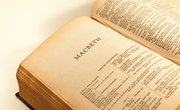One of the most effective learning tools in an English as Second Language, or ESL, classroom is a beautiful piece of English literature. A piece of English literature -- whether a simple poem or a complex novel -- presents the English language as formed by a master wordsmith. These experts can bend the language to do and say beautiful and complicated ideas. In encouraging ESL students to reflect on these beautiful ideas, an ESL teacher can use a wide variety of interesting activities that will not only help students learn the language, but learn it as a powerful, artistic device.
Pairing with Movies
When choosing works of English literature to teach in a ESL classroom, choose pieces that have an accompanying film. This can be a direct film adaptation as with the 1984 film adaptation of George Orwell’s “1984,” or it could be a film that refers to or uses a piece of English literature such as “Dead Poets Society” and its reference to Lord Byron’s poem “She Walks in Beauty.” Films present a piece of literature with multiple modes outside of just written or spoken English, and as such they give ESL multiple ways to make sense of the literature. Additionally, films give teachers an opportunity to consider the topics of context and adaptation, which will encourage students to pay close attention to the written language of the original piece.
Word and Sentence Games
Teachers in an ESL classroom could use different types of word and sentence-based games to help students “decode” ideas, lines or whole passages from a piece of English literature. For example, a teacher might create a crossword puzzle for students to complete based on vocabulary terms from Mark Twain’s “The Adventures of Tom Sawyer.” Students might also play a game like “Who Said it?” in which they must choose which character from a piece of English literature said a particular line. These types of games provide an external motivation -- i.e. “winning” the game -- for the difficult task of decoding and defining English words or sentences.
Listen and Repeat Passages
Teachers might record themselves reading a particularly beautiful or compelling passage from a piece of English literature. They could then share the recording with their ESL students and encourage them to listen to it and then record themselves reading the passage. This gives students an opportunity to practice reading and speaking English all the while appreciating a piece of beautiful writing. Listen and repeat exercises allow ESL students to experience the English language when it is used by master wordsmiths.
Dramatic Play
Dramatic play activities call on students to recreate some scene or moment from a piece of English literature. Students must be able to decipher the original scene which forces them to pay close attention to the language of description (the setting of the scene) as well as the language of action (the activity in the scene), and also the dialogue (what they will speak in the scene). Because dramatic play activities are fundamentally performative in nature, they encourage students to add polish to their spoken words in a way that casual talking does not.
Related Articles
References
- The Effective Use of Motion Pictures in the ESL Classroom; Harlan D. Whatley
- The Internet TSL Journal: Games & Activities for the ESL/EFL Classroom
- Using English: Drilling- Judicious Use of Brute Force in ESL Classroom; Alex Russel
- The Internet TSL Journal: The Benefits of Using Drama in the ESL/EFL Classroom; Chris Boudreault
Writer Bio
Samuel Hamilton has been writing since 2002. His work has appeared in “The Penn,” “The Antithesis,” “New Growth Arts Review" and “Deek” magazine. Hamilton holds a Master of Arts in English education from the University of Pittsburgh, and a Master of Arts in composition from the University of Florida.











